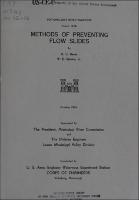Please use this identifier to cite or link to this item:
https://hdl.handle.net/11681/3134Full metadata record
| DC Field | Value | Language |
|---|---|---|
| dc.contributor | United States. Mississippi River Commission | - |
| dc.contributor | United States. Army. Corps of Engineers. Lower Mississippi Valley Division | - |
| dc.contributor.author | Banks, D. C. (Don Charles) | - |
| dc.contributor.author | Strohm, William E. | - |
| dc.date.accessioned | 2016-03-16T14:45:52Z | - |
| dc.date.available | 2016-03-16T14:45:52Z | - |
| dc.date.issued | 1965-10 | - |
| dc.identifier.uri | http://hdl.handle.net/11681/3134 | - |
| dc.description | Potamology Report | - |
| dc.description | Summary: This report summarizes a study of investigations of liquefaction of sands accomplished since 1956 with the purposes of (a) updating Potamology Investigations Report 12-5, "A Review of the Soils Studies", by Dr. M. J. Hvorslev, which was published in June of 1956, and (b) evaluating methods of stabilizing potentially unstable deposits along revetted reaches of the banks of the Lower Mississippi River. The ultimate objective of the study was to determine the most promising method of stabilization for field testing. Recent literature describing liquefaction phenomena, occurrence of flow slides, results of laboratory and field tests dealing with liquefaction of sands, and methods for densifying loose sand and silt deposits is summarized in this report. The results of the literature review support and extend the findings of Report 12- 5. However, no data were found which provide the information that would be obtained from the additional investigations recommended in Report 12-5 on development and progress of arcuate-shaped liquefaction failures, including information on development of excess pore pressures during such failures, and more detailed information on associated soil conditions. These recommended investigations contained in Report 12-5 are still considered desirable, but field experiments can be undertaken now utilizing currently available information to investigate the feasibility of improving the stability of loose sand deposits with respect to flow failure by densification. The most suitable procedure is considered to be densification by the vibroflotation process using the results of an extensive soil investigation before and after densification to determine the success of the densification procedure. The use of explosives to densify loose sand is not considered suitable at present because of the large amount of preliminary experimental investigation that would be required to determine optimum charge weights, depths, spacings, and other factors for the range of conditions to be found at potentially unstable sites. Field experiments to evaluate stabilization by densification are proposed. | - |
| dc.publisher | U.S. Army Engineer Waterways Experiment Station. | - |
| dc.publisher | Engineer Research and Development Center (U.S.) | - |
| dc.relation | http://acwc.sdp.sirsi.net/client/en_US/search/asset/1031740 | - |
| dc.relation.ispartofseries | Potamology investigations report ; no. 12-16. | - |
| dc.rights | Approved for public release; distribution is unlimited. | - |
| dc.source | This Digital Resource was created from scans of the Print Resource | - |
| dc.subject | Potamology | - |
| dc.subject | Mississippi River | - |
| dc.subject | Alluvial valley | - |
| dc.subject | Lower Mississippi | - |
| dc.subject | River | - |
| dc.subject | Soils | - |
| dc.subject | Soil mechanics | - |
| dc.subject | Bank caving | - |
| dc.subject | River banks | - |
| dc.subject | Bank erosion | - |
| dc.subject | Flow failure | - |
| dc.subject | Soil liquefaction | - |
| dc.subject | Revetments | - |
| dc.subject | Revetment failure | - |
| dc.subject | Soil compaction | - |
| dc.subject | Soil densification | - |
| dc.subject | Soil density | - |
| dc.title | Methods of preventing flow slides | - |
| dc.type | Report | en_US |
| Appears in Collections: | Potamology Investigations Report | |
Files in This Item:
| File | Description | Size | Format | |
|---|---|---|---|---|
| Potamology-Investigations-Report-No.-12-16.pdf | 9.01 MB | Adobe PDF |  View/Open |